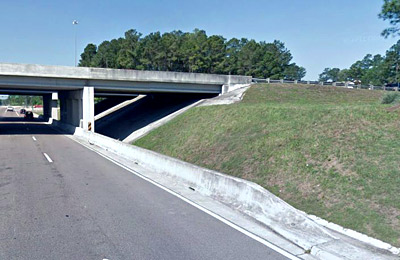I-75 Site
University of Florida Vertebrate Fossil Locality AL018
Location
Southwestern Gainesville, Alachua County, Florida, at the intersection of Interstate Highway 75 (I-75) and SR 121 (Williston Road); 29.6° N, 82.4° W.
Age
- Early Oligocene Epoch; later half of Whitneyan land mammal age
- About 29 million years old (estimated)
Basis of Age
Vertebrate biochronology (presence of Miohippus, Eutypomys, and Centetodon indicate an early Arikareean age or older but lack of definitive Arikareean taxa suggest a pre-Arikareean age. On the other hand, derived specimens of chiropterans and Miohippus suggest an age very close to the Arikareean, thus, a late Whitneyan age is favored [Czaplewski and Morgan, 2012; Emry et al., 1987]).
Geology
Fossils filled in a small, roughly circular area less than 15 feet in diameter and about 6 feet deep filled with dark-brown to black, silty and slightly sandy clay. The sediments were weathered and lacked visible stratification (Patton, 1969).
Depositional Environment
Small, shallow sinkhole developed in the late Eocene Ocala limestone.
Fossils
Excavation History and Methods

Fossil bone was first reported in a roadcut of I-75 by Mervin Kontrovitz, a graduate student in the University of Florida Department of Geology (Patton, 1969). The region was being excavated to pour concrete pilings for an exit from I-75 to Williston Road, and thus the sediment was rapidly excavated and screenwashed. Collection was expedited by the small size of the sinkhole deposit, and fossils were deposited in the Florida Museum of Natural History. Today the former site resides beneath several feet of asphalt, concrete and road fill (Fig. 1). Thomas H. Patton briefly described the fauna and named the I-75 Local Fauna soon after the site was collected (Patton, 1969), yet most of the fossils from this site have received little further attention in the scientific literature, owing in part to their small sample size and frequently broken condition. Currently the only aspects of the fauna to receive scientific attention are the boid and colubrid snakes (Holman, 1999; Holman and Harrison, 2000, 2001), a natalid bat (Morgan and Czaplewski, 2003), the marsupial Herpetotherium (Hayes, 2005), and most recently the speonycterid bats (Czaplewski and Morgan, 2012).
Discussion
While the I-75 Local Fauna is relatively small and poorly studied, it is notable for being the oldest record of terrestrial vertebrates from Florida – particularly from a time when the state was thought to be mostly underwater (Patton, 1969; Hulbert, 2001). The appearance of several large, plains-dwelling taxa such as equids and the carnivore Daphoenus indicate a connection with the mainland, rather than an isolated island. It is possible that the sharks and fish from the site were introduced later, with reworking of the top-most sediments once ocean water reinvaded this region (Patton, 1969). At the time of its discovery many of its species were known only from western North America, thus the I-75 Local Fauna expanded the range of many Oligocene mammals, as well as further establishing ecological connections between Florida and the western Gulf Coast that are well-known in later epochs (Patton, 1969).
Sources
- Original Author(s): Paul Morse
- Original Completion Date: November 30, 2012
- Editor(s) Name(s): Richard C. Hulbert Jr., Natali Valdes
- Last Updated On: July 8, 2021
This material is based upon work supported by the National Science Foundation under Grant Number CSBR 1203222, Jonathan Bloch, Principal Investigator. Any opinions, findings, and conclusions or recommendations expressed in this material are those of the author(s) and do not necessarily reflect the views of the National Science Foundation.
Copyright © Florida Museum of Natural History, University of Florida